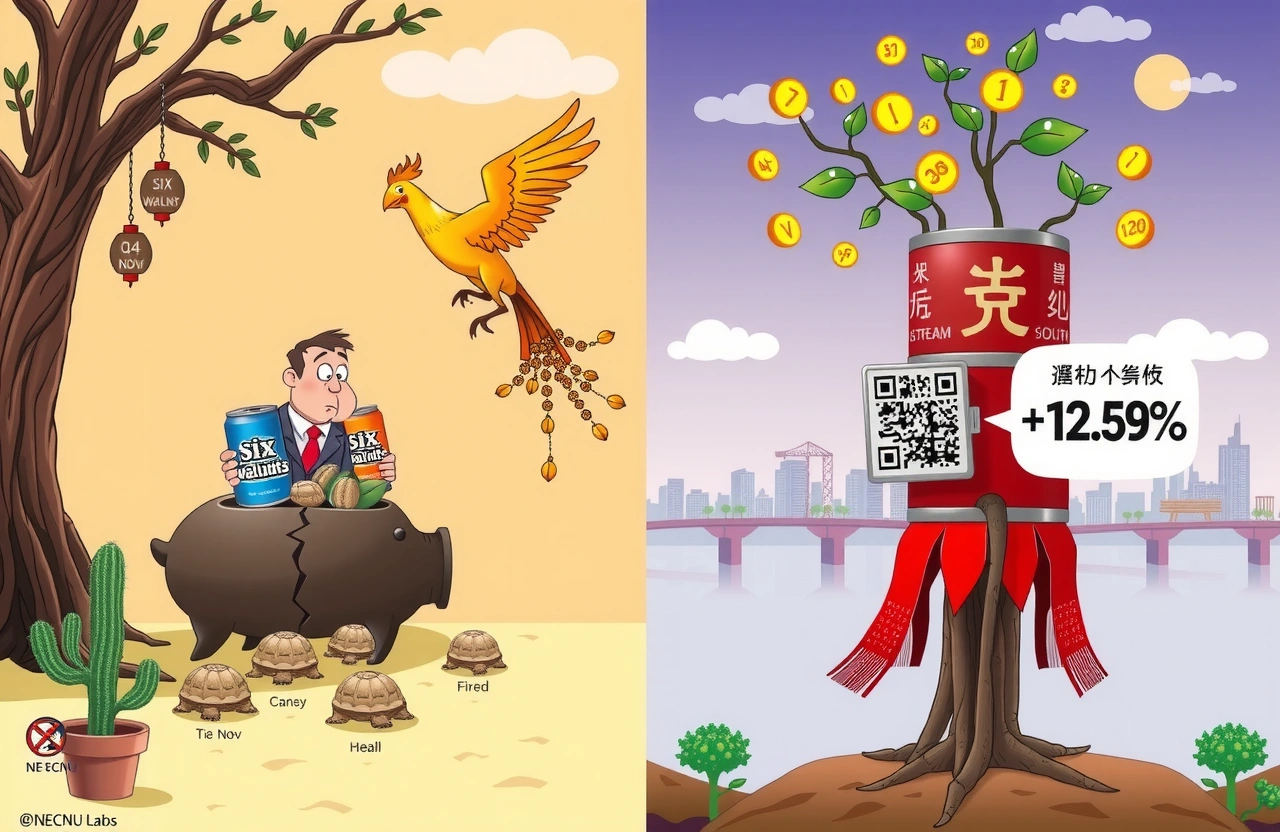Yangyuan Beverage Group, known for its popular ‘Six Walnuts’ drink, recently released disappointing financial results that reveal significant challenges in China’s competitive beverage market. The latest earnings report shows both revenue and profits declining across multiple sales channels and regional markets, raising questions about the company’s growth strategy amid changing consumer preferences.
Key highlights of the earnings report:
- January-September revenue fell 7.81% year-on-year to ¥4.229 billion
- Net profit attributable to shareholders declined 4.69% to ¥1.229 billion
- Q3 alone saw severe contraction with 18.79% revenue drop
- Four major sales regions reported significant year-on-year decreases
- Direct sales increased but couldn’t offset wholesale channel losses
Quarterly Financial Performance Highlights
Yangyuan Beverage’s third-quarter results intensified negative trends observed earlier in 2024. The company reported ¥1.287 billion in revenue for July-September, representing an 18.79% decline compared to the same period last year. More concerning was the net profit plummet of 47.26% to just ¥199 million.
For the full January-September period, the financial picture shows:
- Total revenue: ¥4.229 billion (down 7.81%)
- Net profit: ¥1.229 billion (down 4.69%)
- Cost-to-revenue ratio increased to 35.8%
- Marketing expenses rose by 8.3% year-on-year
Company executives attributed the declining performance primarily to reduced sales volume and lower investment returns from affiliated enterprises. The consistent pattern of revenue and net profit both fall suggests systemic challenges rather than temporary market fluctuations.
Distribution Channel Analysis
Yangyuan Beverage’s sales model relies heavily on traditional wholesale distribution networks supplemented by emerging direct-to-consumer channels. The 9.79% contraction in wholesale revenue to ¥3.965 billion indicates weakening relationships with distributors or diminished market demand. Historically, wholesale accounts for over 90% of Yangyuan’s revenue stream.
Wholesale Challenges
The wholesale contraction reflects several market pressures:
- Increased competition from emerging beverage brands
- Shifting consumer preferences toward low-sugar alternatives
- Distribution disputes reported in Jiangsu and Zhejiang provinces
- Higher inventory pressures among regional distributors
Direct Sales Growth
The relatively small direct sales channel grew 26.72% to ¥239 million, suggesting successful e-commerce initiatives like Tmall and JD.com flagship stores. However, direct sales represent just 5.6% of total revenue and couldn’t compensate for wholesale losses. This channel’s growth indicates potential for digital transformation if properly scaled.
Regional Market Performance Breakdown
The earnings report revealed striking geographic disparities, with revenue and net profit both fall most significantly in key markets accounting for over 70% of national sales. Yangyuan Beverage categorizes its mainland China operations into seven sales regions:
- East China: ¥1.4 billion (9.93% decline)
- Central China: ¥991 million (12.39% decline)
- North China: ¥921 million (7.24% increase)
- Southwest China: ¥520 million (23.59% decline)
- Northwest China: ¥153 million (1.42% increase)
- South China: ¥98 million (6.84% decline)
- Northeast China: ¥120 million (17.73% increase)
Declining Markets: Sales Contraction Analysis
The four declining regions share common challenges:
- East China: Strategic market representing 33% of sales – decreased primarily in Zhejiang and Jiangsu due to competitive pressure
- Central China: Decline concentrated in Hubei reflects increased juice beverage competition
- Southwest China: 23.59% contraction represents Yangyuan’s steepest regional decline
- South China: Smallest regional market showing continued weakening trend
Growth Areas: Bright Spots
Despite overall decline, two regions demonstrated positive performance:
- North China (Beijing/Tianjin/Hebei): Sustained 7.24% growth suggests brand loyalty
- Northeast China: 17.73% expansion indicates successful local promotional campaigns
Strategic Implications and Market Challenges
Yangyuan Beverage faces fundamental headwinds beyond temporary market conditions. The revenue and net profit both fall pattern appears rooted in structural industry shifts:
- Health-conscious consumers shifting toward low-sugar alternatives
- Innovation gap compared to emerging beverage startups
- Over-reliance on flagship Six Walnuts product
- Limited international expansion despite domestic saturation
The company’s heavy investments in intelligent manufacturing facilities in Hebei haven’t yet yielded expected cost efficiencies. Experts suggest Yangyuan’s core product faces perception challenges among younger consumers who view walnut drinks as traditional rather than trendy.
Competitive Landscape Shifts
Yangyuan faces competition from beverage giants:
- Wahaha Group expanding into plant-based drinks
- Coca-Cola China launching premium nut milk lines
- Local startups offering better sugar-reduced options
Incidentally, investor concern grows as Yu Xiuhong, Yangyuan Beverage’s brand director, admitted publicly that “innovation pipeline velocity needs urgent acceleration”.
Market Response and Investor Sentiment
Following the earnings release, Yangyuan Beverage shares declined 4.1% in Shanghai trading. Several brokerages downgraded projections:
- CICC reduced target price by 12%
- UBS downgraded to ‘neutral’
- Nomura cited sustainability concerns
The revenue and net profit both fall outcome triggered analyst reassessments of China’s nut beverage sector growth assumptions. Most concerning to investors was the disproportionate Q3 profit drop compared to revenue contraction.
Future Outlook and Recommended Actions
The path forward requires strategic interventions. Industry observers recommend:
- Product diversification beyond walnut beverages
- Accelerated digital transformation and D2C investment
- Regional marketing tailored to local preferences
- Ingredient innovation addressing health concerns
The company leadership acknowledges the challenges. As CFO Fan Zhiqiang stated: “We’re deploying fresh resources toward emerging channels while consolidating traditional strengths.” Their upcoming Q4 strategy reportedly focuses on:
- New product launches expected in November
- Expanded Douyin livestream sales initiatives
- Corporate gifting partnerships with tech companies
The modern beverage market demands constant adaptation. Companies reversing revenue and net profit both fall patterns invariably do so through consumer-centric innovation. Yangyuan maintains advantages including:
- Strong production infrastructure
- Brand recognition in tier 3-5 cities
- Healthy cash reserves
Yangyuan Beverage’s upcoming performance requires close monitoring. Initial results following restructuring initiatives should emerge in Q4 2024 results. Investors should analyze regional performance metrics in coming quarterly reports to identify improvement signals. Market analysts suggest portfolio diversification across China’s beverage sector until Yangyuan demonstrates consistent recovery patterns matching its ambitious transformation roadmap.



